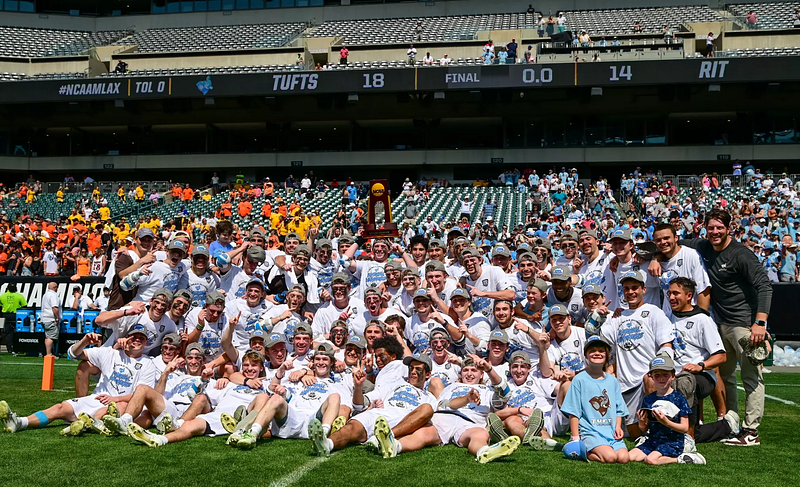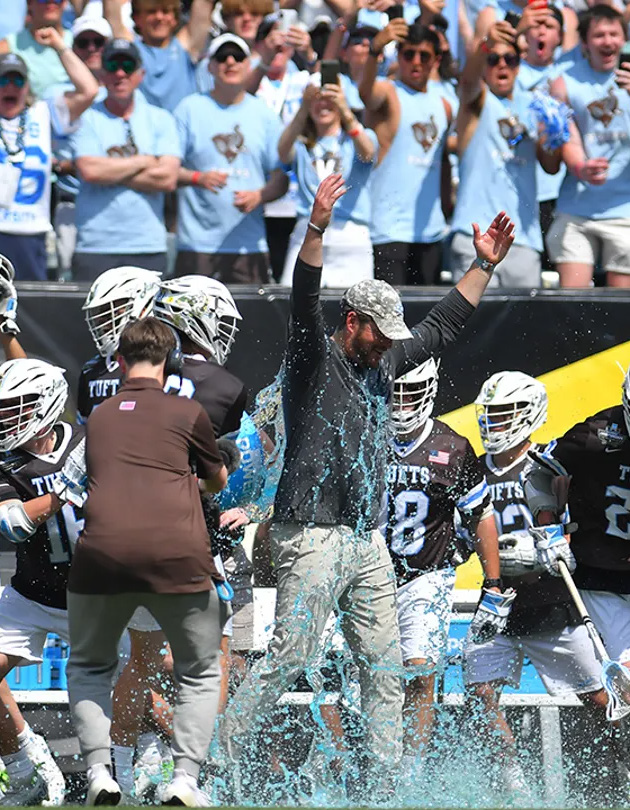
Tufts celebrates a national championship over RIT last spring with a score of 18–14. Photo courtesy of Michael Last
On Monday, Sept. 16, the reigning NCAA Division III men’s lacrosse national champions, Tufts University, engaged in a 45-minute workout led by a Tufts graduate and current Navy SEAL. After practice, 12 players were hospitalized and diagnosed with rhabdomyolysis.
The 12 lacrosse players suffered varying degrees of the condition, with some staying in the hospital for over a week. As of now, all players have been discharged.
These were the first cases of large-scale rhabdomyolysis in all levels of collegiate sports in the past few years. Also known as rhabdo, rhabdomyolysis is a rare but deadly condition that causes a breakdown of muscle, which releases a damaging protein in the bloodstream. Rhabdomyolysis can lead to greater complications like kidney failure or damage, seizures, heart arrhythmias, cardiac arrest, permanent disability and even death.
Treatment for rhabdomyolysis is mainly extensive rehydration, and in rare cases, people need dialysis to filter the blood and remove detrimental chemicals and unsafe levels of electrolytes.
The workout was supposedly voluntary despite the attendance of roughly 50 players, over 88% of the roster. Someone associated with the team allegedly supervised the workout, but it is unclear who. Team Head Coach Casey D’Annolfo was not present for the session. With their recent national championship this past spring, the fourth in program history, team culture may have transformed optional workouts into mandatory ones with the expectation that all players will participate.
Rhabdomyolysis usually results from lengthy, intensive workouts spanning hours, not 45 minutes supposedly optional offseason training. However, the severity of Navy SEAL workouts is known to push people to their limits beyond any typical physical activity. The alumnus who led the workout had recently graduated from the Basic Underwater Demolition/SEAL training program, also known as BUD/S.
BUD/S is a six-month course that strains trainees physically and mentally beyond any typical collegiate athlete’ workout, especially for Division III collegiate athletes. BUD/S training leaves these trainees sleep-deprived, enduring hypothermic conditions, and persisting physical discomfort and pain that is beyond imaginable for the average college athlete. BUD/S is known to cause problems even among the SEALs who undergo them who have the knowledge and preparation to prepare for the physicality of the workout.
The disastrous effects from this one workout may cause alarm for the rest of NESCAC. Coach-led out-of-season practices have only been permitted as of the fall of 2023. NESCAC has been known for its strict offseason regulations compared to other conferences in Division III athletics. Off-season practices have been allowed in other conferences and at most upper level conferences for years.
NESCAC has upheld prioritizing the student above all else and not wearing out the athlete. However, considering that multiple young athletes’ lives were endangered by this extreme off-season workout, NESCAC may reconsider their recently changed regulations. Currently, it is unclear what ramifications the coaches or university may face.
The university has begun investigating the events surrounding the workout and the school’s strength and conditioning rules and regulations. They are focused on overseeing a thorough and unbiased investigation to prevent putting the university’s athletes in danger like this again.

Tufts celebrates with Coach Casey D’Annolfo after National Championship win. Photo courtesy of Larry French